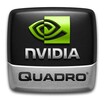NVIDIA Quadro T2000 (Laptop) vs NVIDIA Quadro K3000M vs NVIDIA Quadro K500M
NVIDIA Quadro T2000 (Laptop)
► remove from comparisonThe Nvidia Quadro T2000 for laptops is a professional mobile graphics card that is based on the Turing architecture (TU117 chip). It is based on the consumer desktop GTX 1650 Ti with comparable clock speeds and therefore currently between a mobile GTX 1650 and GTX 1660 Ti. The chip is manufactured in 12nm FinFET at TSMC.
The GPU features 1024 shaders, 64 texture mapping units and 32 ROPs. The 4 GB GDDR5 memory is connected with a 128-bit memory interface and clocked at 2000 MHz. At a TGP of 60W, the clock speeds are specified from 1575 MHz (base) to 1785 MHz (boost).
The Turing generation did not only introduce raytracing for the RTX cards, but also optimized the architecture of the cores and caches. According to Nvidia the CUDA cores offer now a concurrent execution of floating point and integer operations for increased performance in compute-heavy workloads of modern games. Furthermore, the caches were reworked (new unified memory architecture with twice the cache compared to Pascal). This leads to up to 50% more instructions per clock and a 40% more power efficient usage compared to Pascal. In contrary to the faster Quadro RTX cards (e.g. Quadro RTX 3000), the T1000 and T2000 don not feature raytracing and Tensor cores.
NVIDIA Quadro K3000M
► remove from comparison
The NVIDIA Quadro K3000M is a performance-class, DirectX 11.1-compatible graphics card for mobile workstations. It is a Kepler-based GPU built on the GK104 chip (but using only 576 shader cores) and is manufactured in 28nm at TSMC. The Quadro K3000M is built for the Intel Chief River generation (Ivy Bridge) and is the successor to the Fermi-based Quadro 3000M (Huron River platform).
The Quadro series offers certified drivers that are optimized for stability and performance in professional applications like CAD or DCC. OpenGL performance, for example, should be significantly better than GeForce graphics cards of similar specifications.
Architecture
The Kepler architecture is the successor to the Fermi architecture that first appeared in laptops with the GeForce 400M series. The GK104 Kepler core offers eight shader blocks, called SMX, that are clocked at the same speed as the central core. In the K3000M, 3 blocks are active leading to the 576 CUDA cores. Although more shader cores are available in the Kepler architecture as compared to the Fermi design, the Kepler shaders are still expected to be up to twice as power efficient. However, due to the missing hot clock of the shader domain, two shaders of a Kepler chip provide similar performance to just one shader of a Fermi chip (as the latter is clocked twice as fast).
PCIe 3.0 is now supported by the mobile Kepler series and an optional Turbo mode can automatically overclock the Nvidia card by a theoretical 15 percent if the laptop cooling system allows it. The implementation of this boost mode is done in the BIOS, but it is ultimately dependent upon the manufacturer of the laptop.
Performance
The performance is slightly above the older Quadro 4000M based on the fermi architecture. Compared to consumer cards, the K3000M performs similar to the GeForce GT 750M. Games of 2013 can be played fluently in medium or high detail and resolution settings.
Features
The improved feature set now includes support for up to 4 active displays. Furthermore, high resolution monitors of up to 3840x2160 pixels can now be connected using DisplayPort 1.2 or HDMI 1.4a if available. HD-Audio codecs, such as Dolby TrueHD and DTS-HD, can be transmitted via bitstream mode through the HDMI port. However, as most laptops will feature Optimus, the integrated GPU will likely have direct control over the display ports and may limit the feature set available by the Nvidia Kepler cards.
The 5th generation PureVideo HD video processor (VP5) is also integrated in the GK107 core and offers hardware decoding of HD videos. Common codecs such as MPEG-1/2, MPEG-4 ASP, H.264 and VC1/WMV9 are fully supported up to 4K resolutions while VC1 and MPEG-4 are supported up to 1080p. Two streams can be decoded in parallel for features such as Picture-in-Picture. Another novelty is the inclusion of a dedicated video encoding engine similar to Intel QuickSync that can be accessed by the NVENC API.
The power consumption of the K3000M is rated at 75 Watt (TGP according to Nvidia) and is therefore suited for medium-sized notebooks 17-inches or greater.
NVIDIA Quadro K500M
► remove from comparison
The NVIDIA Quadro K500M is an entry-level, DirectX 11.1-compatible graphics card for mobile workstations. It is a Kepler-based GPU built on the GK107 architecture and is manufactured in 28nm at TSMC. Compared to the K2000M, the K500M only features a 64-Bit memory bus and 192 shader cores instead of 384. The Quadro K500M is built for the Intel Chief River generation (Ivy Bridge) and is the successor to the Fermi-based Quadro 1000M (Huron River platform).
The Quadro series offers certified drivers that are optimized for stability and performance in professional applications like CAD or DCC. OpenGL performance, for example, should be significantly better than GeForce graphics cards of similar specifications.
Architecture
The Kepler architecture is the successor to the Fermi architecture that first appeared in laptops with the GeForce 400M series. The GK107 Kepler core offers two shader blocks, called SMX, each with 192 shaders for a total of 384 shader cores that are clocked at the same speed as the central core. The K500M, however, offers only one SMX with 192 shaders. Although more shader cores are available in the Kepler architecture as compared to the Fermi design, the Kepler shaders are still expected to be up to twice as power efficient. However, due to the missing hot clock of the shader domain, two shaders of a Kepler chip are about as fast as one shader of a Fermi chip (as the latter is clocked twice as fast).
PCIe 3.0 is now supported by the mobile Kepler series and an optional Turbo mode can automatically overclock the Nvidia card by a theoretical 15 percent if the laptop cooling system allows it. The implementation of this boost mode is done in the BIOS, but it is ultimately dependent upon the manufacturer of the laptop.
Performance
The gaming performance should be similar to the consumer GeForce GT 620M.
Features
The improved feature set now includes support for up to 4 active displays. Furthermore, high resolution monitors of up to 3840x2160 pixels can now be connected using DisplayPort 1.2 or HDMI 1.4a if available. HD-Audio codecs, such as Dolby TrueHD and DTS-HD, can be transmitted via bitstream mode through the HDMI port. However, as most laptops will feature Optimus, the integrated GPU will likely have direct control over the display ports and may limit the feature set available by the Nvidia Kepler cards.
The 5th generation PureVideo HD video processor (VP5) is also integrated in the GK107 core and offers hardware decoding of HD videos. Common codecs such as MPEG-1/2, MPEG-4 ASP, H.264 and VC1/WMV9 are fully supported up to 4K resolutions while VC1 and MPEG-4 are supported up to 1080p. Two streams can be decoded in parallel for features such as Picture-in-Picture. Another novelty is the inclusion of a dedicated video encoding engine similar to Intel QuickSync that can be accessed by the NVENC API.
The power consumption of the K500M is rated at 35 Watt (TGP according to Nvidia) and therefore suited for medium-sized notebooks of 15-inches or greater.
| NVIDIA Quadro T2000 (Laptop) | NVIDIA Quadro K3000M | NVIDIA Quadro K500M | ||||||||||||||||||||||||||||||||||||||||||||||||||||||||||||||||||||||||||||||||||||||||||||||||||||||||||||||||||||||||||||||||||||||||
| Quadro K Series |
|
|
| |||||||||||||||||||||||||||||||||||||||||||||||||||||||||||||||||||||||||||||||||||||||||||||||||||||||||||||||||||||||||||||||||||||||
| Codename | N19P-Q3 | N14E-Q1 | N14M-Q1 | |||||||||||||||||||||||||||||||||||||||||||||||||||||||||||||||||||||||||||||||||||||||||||||||||||||||||||||||||||||||||||||||||||||||
| Architecture | Turing | Kepler | Kepler | |||||||||||||||||||||||||||||||||||||||||||||||||||||||||||||||||||||||||||||||||||||||||||||||||||||||||||||||||||||||||||||||||||||||
| Pipelines | 1024 - unified | 576 - unified | 192 - unified | |||||||||||||||||||||||||||||||||||||||||||||||||||||||||||||||||||||||||||||||||||||||||||||||||||||||||||||||||||||||||||||||||||||||
| Core Speed | 1575 - 1785 (Boost) MHz | 654 MHz | 850 MHz | |||||||||||||||||||||||||||||||||||||||||||||||||||||||||||||||||||||||||||||||||||||||||||||||||||||||||||||||||||||||||||||||||||||||
| Memory Speed | 8000 MHz | 2800 MHz | 1800 MHz | |||||||||||||||||||||||||||||||||||||||||||||||||||||||||||||||||||||||||||||||||||||||||||||||||||||||||||||||||||||||||||||||||||||||
| Memory Bus Width | 128 Bit | 256 Bit | 64 Bit | |||||||||||||||||||||||||||||||||||||||||||||||||||||||||||||||||||||||||||||||||||||||||||||||||||||||||||||||||||||||||||||||||||||||
| Memory Type | GDDR5 | GDDR5 | DDR3 / GDDR5 | |||||||||||||||||||||||||||||||||||||||||||||||||||||||||||||||||||||||||||||||||||||||||||||||||||||||||||||||||||||||||||||||||||||||
| Max. Amount of Memory | 4 GB | 4 GB | 2048 MB | |||||||||||||||||||||||||||||||||||||||||||||||||||||||||||||||||||||||||||||||||||||||||||||||||||||||||||||||||||||||||||||||||||||||
| Shared Memory | no | no | no | |||||||||||||||||||||||||||||||||||||||||||||||||||||||||||||||||||||||||||||||||||||||||||||||||||||||||||||||||||||||||||||||||||||||
| API | DirectX 12_1, OpenGL 4.6 | DirectX 11, Shader 5.0, OpenGL 4.1 | DirectX 11, Shader 5.0, OpenGL 4.3 | |||||||||||||||||||||||||||||||||||||||||||||||||||||||||||||||||||||||||||||||||||||||||||||||||||||||||||||||||||||||||||||||||||||||
| Power Consumption | 60 Watt | 75 Watt | 35 Watt | |||||||||||||||||||||||||||||||||||||||||||||||||||||||||||||||||||||||||||||||||||||||||||||||||||||||||||||||||||||||||||||||||||||||
| Transistors | 4.7 Billion | 1.3 Billion | ||||||||||||||||||||||||||||||||||||||||||||||||||||||||||||||||||||||||||||||||||||||||||||||||||||||||||||||||||||||||||||||||||||||||
| technology | 12 nm | 28 nm | 28 nm | |||||||||||||||||||||||||||||||||||||||||||||||||||||||||||||||||||||||||||||||||||||||||||||||||||||||||||||||||||||||||||||||||||||||
| Notebook Size | medium sized | large | medium sized | |||||||||||||||||||||||||||||||||||||||||||||||||||||||||||||||||||||||||||||||||||||||||||||||||||||||||||||||||||||||||||||||||||||||
| Date of Announcement | 27.05.2019 | 01.06.2012 | 01.06.2012 | |||||||||||||||||||||||||||||||||||||||||||||||||||||||||||||||||||||||||||||||||||||||||||||||||||||||||||||||||||||||||||||||||||||||
| Features | Optimus, PhysX, Verde Drivers, CUDA, 3D Vision, 3DTV Play | Optimus, PhysX, Verde Drivers, CUDA, 3D Vision, 3DTV Play | ||||||||||||||||||||||||||||||||||||||||||||||||||||||||||||||||||||||||||||||||||||||||||||||||||||||||||||||||||||||||||||||||||||||||
| Information | 118mm2, CUDA, OpenCL 1.2, OpenGL 4.3 |
Benchmarks
3DM Vant. Perf. total + NVIDIA Quadro K3000M
specvp11 snx-01 + NVIDIA Quadro K3000M
specvp12 sw-03 + NVIDIA Quadro T2000 (Laptop)
Cinebench R15 OpenGL 64 Bit + NVIDIA Quadro T2000 (Laptop)
Average Benchmarks NVIDIA Quadro T2000 (Laptop) → 0% n=0
Average Benchmarks NVIDIA Quadro K3000M → 0% n=0
* Smaller numbers mean a higher performance
1 This benchmark is not used for the average calculation
Game Benchmarks
The following benchmarks stem from our benchmarks of review laptops. The performance depends on the used graphics memory, clock rate, processor, system settings, drivers, and operating systems. So the results don't have to be representative for all laptops with this GPU. For detailed information on the benchmark results, click on the fps number.

World of Tanks v8
2012
F1 2012
2012
Dirt Showdown
2012
Diablo III
2012
Anno 2070
2011
Batman: Arkham City
2011
StarCraft 2
2010
Metro 2033
2010| NVIDIA Quadro T2000 (Laptop) | NVIDIA Quadro K3000M | NVIDIA Quadro K500M | |||||||||||||||||||
|---|---|---|---|---|---|---|---|---|---|---|---|---|---|---|---|---|---|---|---|---|---|
| low | med. | high | ultra | QHD | 4K | low | med. | high | ultra | QHD | 4K | low | med. | high | ultra | QHD | 4K | ||||
| World of Tanks v8 | 71 | 36 | 28 | 11 | |||||||||||||||||
| F1 2012 | 168 | 141 | 125 | 52 | |||||||||||||||||
| Torchlight 2 | 130 | 98 | 91 | ||||||||||||||||||
| Dirt Showdown | 96 | 84 | 73 | 23 | |||||||||||||||||
| Diablo III | 179 | 134 | 116 | 73 | |||||||||||||||||
| Anno 2070 | 159 | 62 | 39 | 21 | |||||||||||||||||
| Batman: Arkham City | 144 | 124 | 80 | 40 | |||||||||||||||||
| Deus Ex Human Revolution | 176 | 92 | 34 | ||||||||||||||||||
| Total War: Shogun 2 | 227 | 55 | 20 | ||||||||||||||||||
| StarCraft 2 | 252 | 75 | 59 | 32 | |||||||||||||||||
| Metro 2033 | 98 | 65 | 33 | 10 | |||||||||||||||||
| Anno 1404 | 281 | 63 | |||||||||||||||||||
| Sims 3 | 341 | 183 | 130 | ||||||||||||||||||
| Half Life 2 - Lost Coast Benchmark | 244 | ||||||||||||||||||||
| World of Warcraft | 107 | 159 | 68 | ||||||||||||||||||
| NVIDIA Quadro T2000 (Laptop) | NVIDIA Quadro K3000M | NVIDIA Quadro K500M | |||||||||||||||||||
| low | med. | high | ultra | QHD | 4K | low | med. | high | ultra | QHD | 4K | low | med. | high | ultra | QHD | 4K | < 30 fps < 60 fps < 120 fps ≥ 120 fps | | | | | | | < 30 fps < 60 fps < 120 fps ≥ 120 fps | 4 10 | 2 5 5 | 1 3 5 3 | 5 4 3 | | | < 30 fps < 60 fps < 120 fps ≥ 120 fps | | | | | | |
For more games that might be playable and a list of all games and graphics cards visit our Gaming List



















